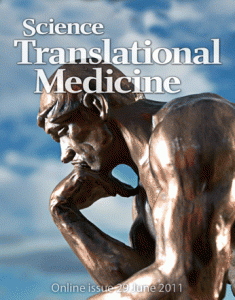Implanted Wireless Microchip offers Osteoporosis Drug Delivery that improves patient Quality of Life
Contrary to popular opinion, innovation is not dead in the biomedical industry, as evidenced by news of a novel drug-delivery system published as a Rapid Publication in Science Translational Medicine (STM) on February 16, 2012.
The paper from Robert Farra of MicroCHIPS, Inc. and research collaborators, describes a first-in-human testing of a wirelessly controlled drug delivery microchip.
Farra et al., report the results of a clinical trial with 8 women in whom microchips were implanted for 103 days. The data showed that the pharmacokinetic profile of microgram-quantities of the anti-osteoporosis drug, teriparatide (FORSTEO), delivered by the microchip was similar to subcutaneous injections. However, the device did fail in one of the 8 women, so data is only reported for 7 patients, a very small patient sample.
The drug delivery device is an array of 600-nL micro reservoirs in which the drug is stored, that is associated with a 13.0 mm x 5.4mm x 0.5mm silicon chip.
The microchip was implanted beneath the skin (subcutaneously) in the abdomen by creating a 2.5cm incision, performed during an outpatient visit.
This paper is also interesting for its use of telemedicine. A remote operator was able to establish a wireless link and send instructions directly to the implant on dosing schedule as well as receive information back on operation of the chip.
John T. Watson, Professor of Bioengineering at the University of California San Diego commented in the accompanying editorial that:
“The microchip represents more than 10 years of engineering design and development efforts to arrive at a programmable, implantable device for subcutaneous release of a therapeutic agent in discrete doses.”
Multiple engineering design advances were made along the way.
He also noted the results from the quality-of-life surveys administered during the trial; the majority of women stating they often forgot they had the device implanted and would readily consent to a fresh implant if needed.
Innovations in drug delivery offer hope of an improved quality of life to patients with chronic disease who require daily injections. In 2010, there were approximately 50,000 teriparatide users, not an insignificant market opportunity. People with diabetes who require daily injection of insulin is another potential market that springs to mind.
The first-in-human results reported in Science Translational Medicine show promise and the potential of a novel implanted wireless drug delivery system.
However, many questions remain unanswered by this research including the reliability & durability of the microchip device, given that it failed in 1 out of 8 women implanted.
Further work on validating the technology, and confirming its safety, reliability and efficacy in a larger sample size will be needed before it can obtain regulatory approval.
References
![]() Farra, R., Sheppard, N., McCabe, L., Neer, R., Anderson, J., Santini, J., Cima, M., & Langer, R. (2012). First-in-Human Testing of a Wirelessly Controlled Drug Delivery Microchip Science Translational Medicine DOI: 10.1126/scitranslmed.3003276
Farra, R., Sheppard, N., McCabe, L., Neer, R., Anderson, J., Santini, J., Cima, M., & Langer, R. (2012). First-in-Human Testing of a Wirelessly Controlled Drug Delivery Microchip Science Translational Medicine DOI: 10.1126/scitranslmed.3003276
Watson, J. (2012). Re-Engineering Device Translation Timelines Science Translational Medicine DOI: 10.1126/scitranslmed.3003687
